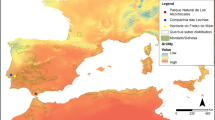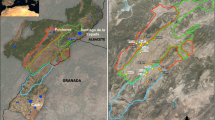Abstract
This article presents a study of shifting cultivation in Guinea-Bissau, illustrating the diversity, flexibility and resilience of these multifold agricultural practices and of its non-linear relation with deforestation and biodiversity conservation. The comparative analysis of the country’s three social and agro-ecological regions shows that the shortest fallows are not associated with the longest cultivation periods and with higher population densities. Further, the fast-track conversion of shifting cultivation into permanent agriculture with orchards is similar in the three regions, and is not occurring in response to land scarcity, shorter fallows and decreasing soil fertility. The article, then, adds depth to the understanding of the complexity of shifting cultivation in Africa and of its multiple routes of transformation into permanent agriculture.









Similar content being viewed by others
Notes
Unpublished data of the Institute of Meteorology of Guinea-Bissau.
References
Boserup E (1965) The conditions of agricultural growth: the economics of agrarian change under population pressure. Allen and Unwin, London
Brady N (1996) Alternatives to slash-and-burn: a global imperative. Agric Ecosyst Environ 58:3–11
Brookfield H, Padoch C (1994) Appreciating agrodiversity: a look at the dynamism and diversity of indigenous farming practices. Environment 36(5):6–21
Brown DR (2006) Personal preferences and intensification of land use: their impact on southern Cameroonian slash-and-burn agroforestry systems. Agrofor Syst 68:53–67
Bryceson D (2002) The scramble in Africa: reorienting rural livelihoods. World Dev 30(5):725–739
Carvalho J, Nunes F (1956) Contribuição para o problema florestal da Guiné Portuguesa. Lisbon: Junta de Investigações do Ultramar
Catarino L (2004) Fitogeografia da Guiné-Bissau. PhD dissertation Lisbon: ISA/UTL.
Catarino L, Martins ES, Pinto Basto MF, Diniz MA (2008) An annotated checklist of the vascular flora of Guinea-Bissau (West Africa). Blumea 53:1–222
Conklin HC (1957) Hanunoo agriculture: a report on an integral system of shifting cultivation in the Philippines. FAO (Forest Development papers, 12), Rome
de Schlippe P (1956) Shifting cultivation in Africa: the Zande system of agriculture. Routledge and Kegan Paul, London
Departamento Central de Recenseamento (1981) Recenseamento Geral da População e da Habitação de 1979: resultados provisórios. Bissau: RGB
Diombera K (1999) Programme d’évaluation des Ressources Forestières Mondiales au Guinée-Bissau, Comissão Europeia, FAO, e Banco Africano para o Desenvolvimento. http://www.fao.org/DOCREP/004/X6807F/X6807F00.HTM Accessed 28 May 2012.
FAO (2006) Global forest resources assessment 2005. Progress towards sustainable forest management. FAO Forestry paper 147
FAO-ISRIC-ISSS (1998) World reference base for soil resources. World Soil Resour Rep 84.
Fox J, Truong DM, Rambo AT, Tuyen NP, Leisz S (2000) Shifting cultivation: a new paradigm for managing tropical forests. BioScience 50(6):521–528
Fujisaka S, Hurtado L, Uribe R (1996) A working classification of slash-and-burn agricultural systems. Agrofor Syst 34:151–169
Geist HJ, Lambin E (2002) Proximate causes and underlying driving forces of tropical deforestation. BioScience 52(2):143–150
Gleave M (1996) The length of the fallow period in tropical fallow farming systems: a discussion with evidence from Sierra Leone. Geogr J 162:14–24
Governo da Guiné (1963) Portaria nº 1557 de 29 de Junho de 1963 que aprova o Regulamento Florestal. Boletim Oficial da Guiné 26.
Guyer J, Lambin E (1993) Land use in an urban hinterland: ethnography and remote sensing in the study of African intensification. Am Anthr 95(4):839–859
Horta A (1965) Análise estrutural e conjuntural da economia da Guiné. Boletim Cultural da Guiné-Portuguesa 20(80):333–496
IBAP (2007) Estratégia Nacional para as Áreas Protegidas e a Conservação da Biodiversidade na Guiné-Bissau 2007–2011. IBAP, Bissau
Ickowitz A (2006) Shifting cultivation and deforestation in tropical Africa: critical reflections. Dev Change 37(3):599–626
Ickowitz A (2011) Shifting cultivation and forest pressure in Cameroon. Agric Econ 42:207–220
INEC (2009) Recenseamento Geral da População e Habitação de 2009. (unpublished results).
Jalloh A, Roy-Macauley H, Sereme P (2011) Major agro-ecosystems of West and Central Africa: brief description, species richness, management, environmental limitations and concerns. Agric Ecosyst Environ 157:5–16
JIU (Junta de Investigações do Ultramar) (1959) Censo da população de 1950: província da Guiné, 2 vol. Junta de Investigações do Ultramar, Lisbon
Kotto-Same J, Woomer P, Appolinaire M, Louis Z (1997) Carbon dynamics in slash-and-burn agriculture and land-use alternatives in the humid forest zone in Cameroon. Agric Ecosyst Environ 65:245–256
Lambin E, Turner B, Geist H et al (2001) The causes of land-use and land-cover change: moving beyond myths. Glob Environ Change 11:261–269
Maffi L (2007) Biocultural diversity and sustainability. In: Pretty J (ed) The Sage handbook of environment and society. Sage, Los Angeles, pp 267–277
Mather AS, Needle CL (2000) The relationships of population and forest trends. Geogr J 166(1):2–13
Mayaux P, Pekel JF, Desclée B et al (2013) State and evolution of the African rainforests between 1990 and 2010. Philos Trans Royal Soc B 368:20120300
Mertz O, Wadley R, Nielsen U et al (2008) A fresh look at shifting cultivation: fallow length an uncertain indicator. Agric Sys 96:75–84
Mertz O, Leisz S, Heinimann A et al (2009) Who Counts? Demography of Swidden cultivators in Southeast Asia. Hum Ecol 37:281–289
Metzger JP (2003) Effects of slash-and-burn fallow periods on landscape structure. Environ Conserv 30(4):325–333
Ministério da Agricultura e do Desenvolvimento Rural (2006) Projeto do Plano de Acção Nacional da Luta Contra a Desertificação na Guiné-Bissau. MADR, Bissau
Mota A (1954) Guiné portuguesa, vol I. Agência Geral do Ultramar, Lisbon
Nyerges E (1989) Coppice swidden fallows in tropical deciduous forests: biological, technological and sociocultural determinants of secondary forest successions. Hum Ecol 17(4):379–400
Oom D, Lourenço P, Cabral A, Vasconcelos MJ, Catarino L, Cassamá V, Moreira J (2009) Quantification of deforestation rates in Guinea-Bissau: a baseline for carbon trading under REDD, 33rd International Symposium on Remote Sensing of Environment, May 4–8, 2009. Stresa: Italy.
Palm C, Vosti S, Sanches P et al (2005) Slash-and-burn agriculture: the search for alternatives. Columbia University Press, New York
Pollini J (2009) Agroforestry and the search for alternatives to slash-and-burn cultivation: from technological optimism to a political economy of deforestation. Agric Ecosyst Environ 133:48–60
Richards P (1985) Indigenous agricultural revolution: ecology and food production in West Africa. Hutchinson, London
Richards P (1993) Agriculture as a performance. In: Chambers R, Pacey A, Thrupp LA (eds) Farmer First. ITP, London, pp 39–43
Rudel TK (1989) Population, development, and tropical deforestation: a cross-national study. Rural Sociol 54(3):327–338
Ruthenberg H (1976) Farming systems in the tropics. Clarendon Press, Oxford
Secretaria de Estado do Plano (1996) Recenseamento geral da população e habitação 1991. INEC, Lisbon
Sirois MC, Margolis H, Camiré C (1998) Influence of remnant trees on nutrients and fallow biomass in slash and burn agroecosystems in Guinea. Agrofor Syst 40:227–246
Temudo MP, Abrantes M (2014) The cashew frontier in Guinea-Bissau, West Africa: changing landscapes and livelihoods. Hum Ecol 32(2):217–230
Temudo MP, Silva JMN (2011) Agriculture and forest cover change in post-war Mozambique. J Land Use Sci 6(4):1–18
Thrupp LA, Hecht S, Browder J (1997) The diversity and dynamics of shifting cultivation: myths, realities and policy implications. World Resources Institute, Washington DC
Tiniguena AD, Alternag (1992) Salvaguarda das últimas florestas primárias sub–húmidas da Guiné–Bissau. Documento de projecto (1992–1994). AD, Tiniguena, Alternag, Bissau
Acknowledgments
Research in 2008 and 2009 was conducted within the framework of the project ‘Assessment of CO2 removal capacity and quantification of carbon stocks in the forests of Guinea-Bissau’ funded by the Guinea-Bissau and Portuguese governments, and by grants from the Portugal-Africa Foundation. In 2011 and 2012 fieldwork was continued within the framework of PTDC/AFR/111546/2009 and PTDC/AFR/1117785/2010 projects, funded by the Portuguese Foundation for Science and Technology (FCT). Insightful comments had been made by José Miguel Pereira, Florent Okry, Dominic Gleaver, Jean-Louis Couture, Amy Ickowitz, João Silva, Luís Catarino and Duarte Oom. The first author also thanks the Department of Anthropology of Yale and the Technology and Agrarian Development Group of Wageningen University, for the feedback provided when she was a Visiting Fellow in 2010–2011 and in April 2010, respectively. The second author acknowledges the Compromisso com a Ciência 2007 contact supported by FCT.
Conflict of interest
The authors declare no conflict of interest.
Author information
Authors and Affiliations
Corresponding author
Rights and permissions
About this article
Cite this article
Temudo, M.P., Figueira, R. & Abrantes, M. Landscapes of bio-cultural diversity: shifting cultivation in Guinea-Bissau, West Africa. Agroforest Syst 89, 175–191 (2015). https://doi.org/10.1007/s10457-014-9752-z
Received:
Accepted:
Published:
Issue Date:
DOI: https://doi.org/10.1007/s10457-014-9752-z




